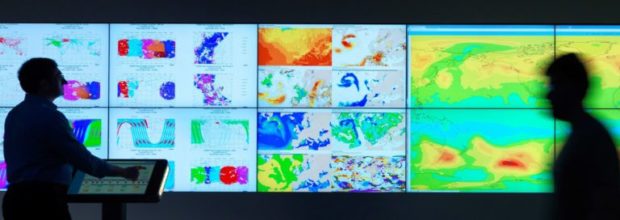European scientists who feed critical climate data to industry and researchers said that their next great breakthrough in weather forecasting will be powered by artificial intelligence.
The European Centre for Medium-Range Weather Forecasts is turning to machine learning in order to structure ballooning volumes of information being processed from satellites and climate stations. A 10-year plan, published Tuesday, paves the way to crunch more data for farmers and utilities who rely on ECMWF forecasts to make business decisions.
“The accuracy of Earth system models contribute to the protection of life and property on this planet in the face of environmental and climate change,” Director General Florence Rabier said. “ECMWF’s use of AI and machine learning will be a game-changer in continuing to make increasing amounts of data and information freely available for and, most importantly, usable by anyone.”
Improving the accuracy of weather forecasts has become increasingly critical as the world tries to mitigate climate change. Timely information about wind flows and solar radiation are needed for grid operators to plan intermittent electricity. Air quality and emissions data inform policy decisions on congestion management and tariffs.
The ECMWF’s pursuit of artificial intelligence will feed into the European Union’s broader multibillion-euro program to create a digital simulation of Earth. The Destination Earth initiative could produce it’s first digital-twin models before the end of this decade, the European Space Agency’s incoming director general Josef Aschbacher told Bloomberg earlier this month.
The pivot toward AI and machine learning has been met with skepticism by some climate scientists who view the technology “as a threat” to their domains of research, according to a separate ECMWF technical report. Some are concerned by black-box approaches that don’t offer physical understanding of the underlying data.
“It it will be increasingly difficult to distinguish between scientists working on machine learning and domain scientists in the future,” read the report. “It will no longer be possible to identify the tools that were originally targeted for machine learning applications in 10 years from now.”
*Photo: Bloomberg





















 California Workers Comp Combined Ratio for 2024 Highest in 20-Plus Years
California Workers Comp Combined Ratio for 2024 Highest in 20-Plus Years  Berkshire Hathaway Enters Post-Buffett Era as Share Prices Fall
Berkshire Hathaway Enters Post-Buffett Era as Share Prices Fall  Northern California Flooding This Weekend Caused by Heavy Rain, High Tides
Northern California Flooding This Weekend Caused by Heavy Rain, High Tides  NOAA Announces Latest AI-Driven Global Weather Models
NOAA Announces Latest AI-Driven Global Weather Models 









